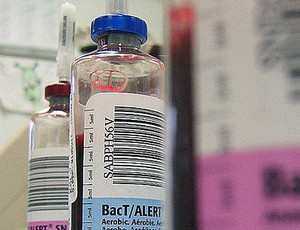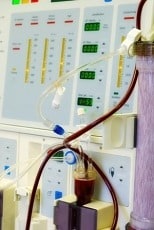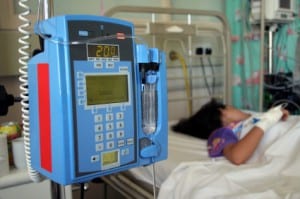Central venous line and dialysis catheter position affects drug clearance

The aim of this experimental study was to investigate if the position of CVC and CVDC influences the elimination of infused drugs, during continuous renal replacement therapy (CRRT)” Frithiof et al (2018). Abstract: In intensive care, drugs are commonly administered through central venous catheters (CVC). These catheters and central venous dialysis catheters (CVDC) are often […]
Central venous catheter-associated venous thromboembolism in children

In pediatric oncology, the diagnosis of a hematologic malignancy and presence of a central venous catheter (CVC) have been identified as significant risk factors for the development of a venous thromboembolism (VTE)” Onyeama et al (2018). Abstract: In pediatric oncology, the diagnosis of a hematologic malignancy and presence of a central venous catheter (CVC) have […]
Reducing infusion pump alarms through structured interventions
Alarm fatigue is defined as sensory overload created by an immense number of alarms, which can be either true or false, actionable or nonactionable, and many that are deemed nuisance, all of which result in desensitization of clinicians” Matocha (2018). Abstract: Disturbing noise heard when walking through a hospital has been linked to a serious […]
Risk factors associated with non-mucosal barrier injury CLABSI

Intrinsic risk factors related to treatment and high rates of central line utilization, necessary in HSCT and hematology oncology patients, are reasons hypothesized for CLABSI’s continued overrepresentation in oncology populations” Sams et al (2018). Background: Central Line Associated Blood Stream Infections (CLABSI) have decreased in hospitalized patients. Despite the National HealthCare Safety Network (NHSN) addition […]
Impact of antibiotic administration on blood culture positivity at the beginning of sepsis

Obtaining blood cultures under antibiotic therapy is associated with a significant loss of pathogen detection. This strongly emphasizes the current recommendation to obtain blood cultures prior to antibiotic administration in patients with sepsis” Scheer et al (2018). Abstract: Objectives: Sepsis guidelines recommend obtaining blood cultures before starting anti-infective therapy in patients with sepsis. However, little […]
Quality indicators assessing antibiotic use in the outpatient setting

We identified a set of 32 outpatient QIs to measure the appropriateness of antibiotic use. These QIs can be used to identify targets for improvement and to evaluate the effects of antibiotic stewardship interventions” Le Maréchal et al (2018). Abstract: OBJECTIVES: Quality indicators (QIs) assessing the appropriateness of antibiotic use are essential to identify targets […]
Effectiveness of antimicrobial-coated central venous catheters for preventing CLABSI

Outcomes are superior for catheters impregnated with chlorhexidine/silver sulfadiazine or other antibiotics than for standard catheters in preventing CRBSIs and catheter colonization under bundles” Wang et al (2018). Abstract: Background: Catheter-related blood-stream infections (CRBSIs) are the most common complication when using central venous catheters (CVCs). Whether coating CVCs under bundles could further reduce the incidence […]
Multimodal approach to reduce vascular access infection in an outpatient dialysis unit

We aimed to describe the incidence of vascular access infections (VAI) over the course of 33 months after implementation of continuous and systematic interventions in an outpatient dialysis unit in Sao Paulo, Brazil” Scorzoni Lessa et al (2018). Background: Central lines have high risk of infection in outpatient hemodialysis, which leads to increased morbidity and […]
Review of ON-Q infusion pump use in orthopaedic surgery

The most notable contribution of this study was the discovery of the adverse effects of the continuous pain pump, ON-Q. Patients treated with this modality had decreased ambulation on postoperative day one and on average remained in the hospital one extra day, a variable that significantly increases the cost of a total knee arthroplasty for […]
Renal vascular access history of a 59years-old male with morbid obesity

Describe the VA history of a 59years-old male with morbid obesity and end-stage chronic kidney disease” Pinto Sousa et al (2017). Abstract: INTRODUCTION: Creating and maintaining a functional vascular access(VA) is a critical factor in the survival of a dialysis patient. However, it will not function forever, implying a creative attitude from the vascular surgeon […]
Quality improvement in mucosal barrier injury laboratory-confirmed bloodstream infections

Rates of CLABSI and MBI-LCBI in a hematology-oncology unit at an academic hospital started climbing in April 2016. A comprehensive multidisciplinary approach was implemented to mitigate the risk. These were the results in the decline of the rates of both CLABSI and MBI-LCBI” Riley et al (2018). Background: Bloodstream infection, including central line-associated bloodstream infection […]
Ultrasound-guided central venous catheter placement in the emergency department

The objective of this study was to describe the experience regarding placement of ultrasound-guided CVCs by emergency physicians in an institution in Bogotá, as well as the associated complications” Devia Jaramillo et al (2018). Abstract: INTRODUCTION: The use of central venous catheters (CVCs) in the emergency room (ER) is a valuable tool for the comprehensive […]
Decreasing CLABSI incidence associated with decreasing MRSA bacteremia

We compare these indicators and how our efforts to reduce CLABSI affects our MRSA bacteremia LabID Event” Beverly et al (2018). Background: The Centers for Medicare and Medicaid Services (CMS) mandates that acute-care hospitals report central line-associated blood stream infections (CLABSI) and MRSA bacteremia LabID events. We compare these indicators and how our efforts to […]
Eliminating neonatal central line associated bloodstream infections

Our 40 bed level III NICU noted an increased incidence of central line associated bloodstream infections (CLABSI) after having zero infections for six quarters” McGowan (2018). Background: The neonatal intensive care unit (NICU) specializes in the critical care of ill or premature newborn infants that are at high risk for hospital acquired infections. Central line […]
Inter-professional approach to decrease the incidence of CLABSI

The goal of this intervention is to decrease CLABSI incidence house-wide by standardizing line selection criteria, care, maintenance, and evaluation for blood cultures” Khalid et al (2018). Background: CLABSIs are serious infections associated with increased length of stay and mortality. Variability existed in facility practices regarding line choice, care, and maintenance of central venous lines […]
Treatment and secondary prophylaxis with ethanol lock therapy for central line-associated bloodstream infection

We evaluated ethanol lock therapy as treatment and secondary prophylaxis for CLABSI in children with cancer or haematological disorders” Wolf et al (2018). Abstract: BACKGROUND: Central line-associated bloodstream infections (CLABSIs) affect about 25% of children with cancer, and treatment failure is common. Adjunctive ethanol lock therapy might prevent treatment failure but high-quality evidence is scarce. […]
Peripheral IV bundle example published as a free full text IVTEAM Original

This article aims to offer an insight into an innovative approach to modern bundle design with a review of a peripheral IV catheter insertion and care bundle” Jackson (2018). Abstract: From a global perspective, central line bundle implementation has dramatically reduced the incidence of central line associated bloodstream infections (CLABSI). Bundles act as a procedural […]
Drug libraries that target controlled intravenous infusions in the obese

It is our hope that commercially available pumps will soon incorporate these new models to improve the performance of this technique in the obese population” Cortínez and Anderson (2018). Abstract: PURPOSE OF REVIEW: The use of conventional pharmacokinetic parameters sets ‘models’ derived from nonobese patients has proven inadequate to administer intravenous anesthetics in the obese […]
Risks of long-term implantable port use in enzyme replacement therapy

This case series describes potential complications associated with long-term TIVAD use, such as compromise of skin integrity, infection, or port failures” Hendriksz et al (2018). Abstract: Totally implantable vascular access devices (TIVADs) are commonly used in conjunction with enzyme replacement therapy (ERT) for lysosomal storage disorders (LSDs). This case series describes potential complications associated with […]
Hand compartment syndrome due to N-acetylcysteine extravasation

We describe a hand compartment syndrome after extravasation of NAC requiring emergent fasciotomy during phase three of treatment for suspected APAP toxicity. Extravasation injuries leading to compartment syndrome are rare” Thoppil et al (2018). Abstract: N-acetylcysteine (NAC) is the antidote for acetaminophen (APAP)-induced hepatotoxicity. Both intravenous (IV) and oral (PO) NAC formulations are available with […]
Complications and nursing management of hepatic arterial infusion pumps

The hepatic arterial infusion (HAI) pump is a treatment-delivery method based on the principle of targeting the tumor site directly and can be used alone or in combination with systemic chemotherapy” Italiano (2018). Abstract: BACKGROUND: The hepatic arterial infusion (HAI) pump is a treatment-delivery method based on the principle of targeting the tumor site directly […]
Efficiency of electrocardiogram monitor for positioning PICC tip placement in neonates

During the PICC placement in neonates, the use of ECG monitor to determine the position of catheter tip can improve the one-time success rate of placement and reduce the time spent on placement” Ling et al (2018). Abstract: OBJECTIVE: To study the efficiency of electrocardiogram (ECG) monitor for positioning the catheter tip in the placement […]
Standardization of the infusion sequence of antineoplastic drugs

In this way, this study aimed to evaluate the infusion order of antineoplastic agents of the main therapeutic protocols used in the treatment of colorectal and breast cancer which are used in a tertiary hospital, identifying possible interactions dependent on the infusion sequence” Silva et al (2018). Abstract: The definition of antineoplastic administration sequences can […]
Implementation of a closed system transfer device in oncology units

The objective of this study was to evaluate the effect of CSTD implementation on central line-associated bloodstream infection (CLABSI) rates” Fox et al (2018). Background: In February 2016 the United States Pharmacopeia introduced general chapter 800 requiring the use of closed system transfer devices (CSTD) for preparation and administration of antineoplastic hazardous drugs. The objective […]
Adverse events among OPAT patients receiving daptomycin versus vancomycin

In the OPAT setting, vancomycin use was associated with higher incidence of ADEs than daptomycin use. This finding is an important policy consideration for programs aiming to optimize outcomes and minimize cost. Careful selection of gram-positive agents for prolonged treatment is necessary to limit toxicity” Schrank et al (2018). Abstract: OBJECTIVE: Outpatient parenteral antimicrobial therapy […]
Systematic review for the medical and surgical management of necrotizing soft tissue infections

To assess the effects of medical and surgical treatments for necrotizing soft tissue infections (NSTIs) in adults in hospital settings” Hua et al (2018). Abstract: BACKGROUND: Necrotizing soft tissue infections (NSTIs) are severe and rapidly spreading soft tissue infections of the subcutaneous tissue, fascia, or muscle, which are mostly caused by bacteria. Associated rates of […]
Savings associated with bedside peripherally inserted central catheter tip confirmation

In this retrospective case control study, we examine costs related to these 2 tip confirmation methods while assessing overall cost savings to the health care industry” Patel et al (2018). Abstract: Peripherally inserted central catheter use has increased dramatically over the past decade, parallel to health care costs. Traditional bedside peripherally inserted central catheter placement […]
When IV route not available consider a rectal catheter for rapid medication and fluid administration

Patients in both the post-acute and acute care settings often require fluid and/or medication when their oral route is compromised and vascular access may not be warranted or immediately accessible. The rectum is an underutilized administration point that can be accessed with speed and relative ease” Macygin et al (2018). Abstract: Health care providers are […]
Study identifies early CLABSI in patients with haematological malignancies

We observed a high prevalence of early central venous catheter associated blood stream infection mainly in patients with haematological malignancies. Our study highlights the importance of preventive measures in reducing infections in paediatric cancer patients” Moell et al (2018). Abstract: AIM: This study examined the clinical characteristics of central line associated blood stream infections occurring […]
CLABSI underreporting and data accuracy remains a major concern

CLABSI underreporting remains a major concern; validations conducted by SHDs provide an important impetus for improved reporting. SHDs are uniquely positioned to engage facilities in collaborative validation reviews that allow transparency, education, and relationship building” Bagchi et al (2018). Abstract: Background: Numerous state health departments (SHDs) have validated central line–associated bloodstream infection (CLABSI) data, and […]

